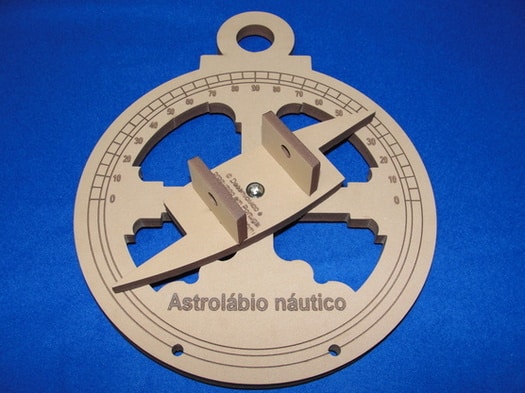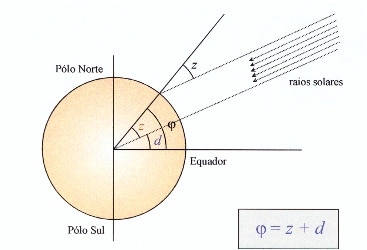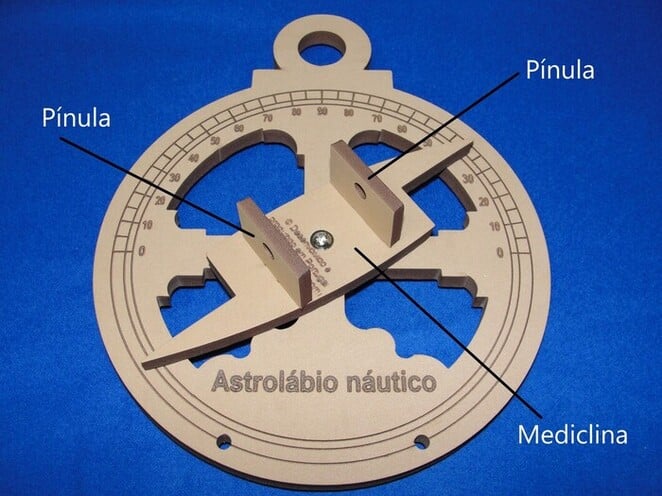
It took a lot of courage from the Portuguese sailors who made the first great voyages of the Discoveries. There were terrible rumours about what was beyond the sea. It was believed that in the West the Atlantic Ocean would end in a huge cataract and that in the South, where the Sun reaches its peak, the heat would burn the ships.
There was a real difficulty that made navigation on the high seas difficult (to determine latitude and longitude) because the only points of orientation were the Sun and the stars.
In the Middle Ages the astrolabe planisphere was used to measure the height of the stars. This was an invention of the human genius of Greek antiquity which was perfected over the centuries in Europe and by the Arabs.
It was a very complex and delicate instrument (a real analogue computer) which also made it possible to calculate the time from the position of the sun and to predict the position of the stars on a particular day of the year and at a particular time.

The Astrolabe and its importance to the Portuguese Discoveries
To determine the problem of latitude Portuguese cosmographers and navigators took the astrolabe planisphere and simplified it.
Thus, the nautical astrolabe more robust and heavy, did not offer great resistance to wind and remained easily upright, even in the difficult conditions of navigation on the high seas.
It proved to be an effective instrument and of great use for navigation, because with its help was possible to accurately mark the position on Earth (latitude).
Working principle of the astrolabe
O astrolabe is an instrument for measuring angles.
The nautical astrolabe was used to measure the angular height of the stars, namely the Sun at noon (or the North Star at night).
For that purpose, the 'mediclina' had two small plates (the 'pinnules') with holes in the central parts, through which the stars were peered at or the light from the sun was projected, to align that aim with the direction of the star.
By measuring the angle that the sun (or the Pole Star) made with the horizon it was possible to calculate the latitude of the place, thus identifying the navigational position on Earth.
Previous recommendation!
This astrolabe is made of a resistant but very light material. In order to make it heavier (like the ones that were used in reality) two holes were made at the bottom of the astrolabe that allow a thread to pass through.
This thread should be attached to the neck of a full plastic water bottle (a 33cl bottle is enough) so that when you hang the astrolabe, it can be used, just like in the 15th century!
Measurement of the inclination relative to the sun - how to do it
The observer hangs the astrolabe by its ring and sets the wheel in the vertical plane of the sun.
He then turns the "Mediclina" so that the sunlight passes through the two holes of the pinnules.
The reading taken by the sharp point of the "Mediclina" at the graduation of the wheel indicates the height of the sun (zenith distance z).
The latitude is the angle φ, formed by the vertical of the place with the equator, measured on the meridian of the place. As shown in the figure, this angle is the sum of the sun's zenith distance z, and the declination of the sun (d) when it passes through the meridian of the place, i.e. at true solar noon.
With the astrolabe the angle z is measured by pointing the "mediclina" towards the sun and in an astronomical table the value of the declination (d) is read, at solar noon for that day.

This measurement must be made at the instant when the sun passes through the meridian of the place, that is, at the instant when its height is maximum in the place.
For this to happen, just before solar noon, the observer orients the instrument and rotates the "mediclina" so as to keep a ray of sunlight passing through the two holes.
Before noon the upper end goes up, ever so slowly; reaching its maximum, it begins to descend.
The greatest height, which corresponds to solar noon, is the required angle. In this way, the astrolabe also indicates the true noon without the need for a clock.
Challenge
The astrolabe astrolabe was also used for other purposes. The Greeks used it to measure the height of buildings or the depth of wells.
We leave you a challenge: on a sunny day use the astrolabe to determine the height of your house, your school or the trees in the garden!
Good luck!
("Measuring the inclination relative to the Sun - how to do it" - text adapted from "Esquema de funcionamento do astrolábio", A.S. Alves and Claudino Romeiro, Observatório Astronómico da Universidade de Coimbra).
Like it? Then share it!

